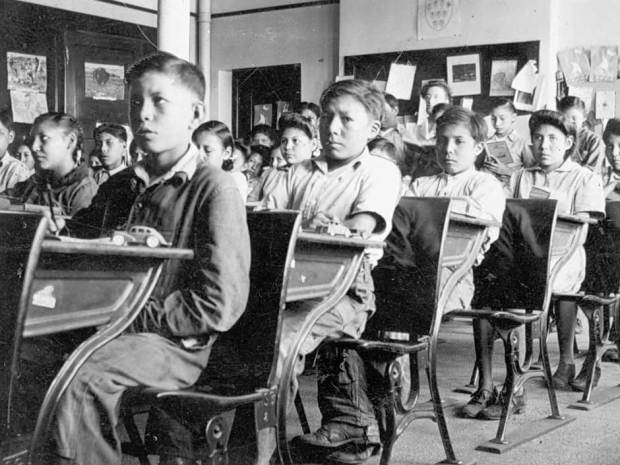Reading Analysis #5:
In the upcoming lecture, we will be discussing and trying to understand the topic of “Separate Childhoods and Indigenous Education”. However, we were first assigned readings to give us come context on what we will be discussing. Within this topic, the readings pertained to the establishment of residential schools for Aboriginal children, and how these schools were unequal in their teachings, the children’s experiences within these schools and how that influenced their childhood.
In Jean Barman’s article, “Schooling for Inequality: The Education of British Columbia Aboriginal Children”, she focuses on the emergence of these schools and the reasons for this. She also integrates into her article the inequality within these schools, the curriculum and experiences the children had while attending these schools. The purpose of these schools was the “assimilation [of the Aboriginal children] into mainstream Canadian society”[1], and “by taking children away from the old ways and ‘civilizing’ them into European ways… ‘the Indian problem’ would be solved”[2]. The education aspect within these schools was noted as having “shorter time periods for classroom instruction… forced to study in a second language… taught in the English language exclusively [and in addition to this the] boys learned how to do farm chores or some low status trade… [the] girls performed household tasks”[3] and religious instruction was also implemented into their curriculum. These aspects of education that the Aboriginal children were forced to do was difficult to accomplish mainly because these children were stripped of their traditional culture and trying to be converted to something they had no desire to be. Within these schools, the treatment, and the experiences the children endured were horrendous. They were subjected to emotional, “physical and sexual abuse”[4], discrimination, amongst other things, which influenced their time in the schools and also had negative effects on their childhood.
In Helen Raptis’ article, “Implementing Integrated Education Policy for On-Reserve Aboriginal Children in British Columbia, 1951-1981, she focuses on residential schools between 1951 and 1981. She explains how “most Aboriginal children attended nationally-funded, church-administered schools”[5]. In addition to this, Raptis states that “during the early decades of the twentieth century, the decision to integrate or segregate Aboriginal children was dependent on various factors”[6], such as economic and financial factors. This residential school experience as many people refer to it as influenced the Aboriginal children in many ways such as the “acts of violence, and abuse”[7], the lack of funding resulting in inadequate food, clothing, and health care. In addition to this, the labour and religious instruction that was implemented in these schools effected their educational experience and overall their childhood.
All of these articles contribute to the main topic that will be further discussing in our lecture. The topics of separate childhoods and Indigenous education are important topics that must be discussed in order to understand the history of childhood and education. These articles show the main way Indigenous children were educated and evidently endured separate childhoods and did not have good experiences growing up, which was through the implementation of residential schools. These schools had religious instruction, very basic curriculum which enforced English and disregarding their native language, labour and other domestic skills, and in addition to this, there was abuse both emotional and physically within these schools and overall child care was far from adequate. These factors influenced both the quality and amount of education these children received and how they grew up. All of these articles contribute to the wider historiography of the topic, and helps us to better understand their part on Canadian history.
Endnotes:
[1] Jean Barman, “Schooling for Inequality: The Education of British Columbia Aboriginal Children,” in Sara Burke and Patrice Milewski (Eds), Schooling in Transition: Readings in the Canadian History of Education, Toronto: University Press, 2012: 255.
[2] Ibid., 255-256.
[3] Ibid., 260, 261.
[4] Ibid., 255.
[5] Helen Raptis, “Implementing Integrated Education Policy for On-Reserve Aboriginal Children in British Columbia, 1951-1981,” Historical Studies in Education 20, no. 1 (Spring 2008): 119.
[6] Ibid., 120.
[7] Paige Raibmon, “‘A New Understanding of Things Indian’: George Raley’s Negotiation of the Residential School Experience,” BC Studies 110 (1996): 96.
Bibliography:
Barman, Jean. “Schooling for Inequality: The Education of British Columbia Aboriginal Children.” in Sara Burke and Patrice Milewski (Ed.), Schooling in Transition: Readings in the Canadian History of Education, Toronto: University of Toronto Press, 2012” 255-276.
Raptis, Helen. “Implementing Integrated Education Policy for On-Reserve Aboriginal Children in British Columbia, 1951-1981.” Historical Studies in Education 20, no. 1 (Spring 2008): 118-146.
Raibmon, Paige. “‘A New Understanding of Things Indian’: George Raley’s Negotiation of the Residential School Experience.” BC Studies 110 (1996): 69-96.
Reflections:
I chose to include this reading analysis into my ePortfolio because it connected to one of my aspects I want to discuss, and it also connects to my main research project. This aspect is the segregation and discrimination of children in terms of race, such as the Indigenous children to Residential schools or other schools that kept them away from the white population. This not only effected their education they received but also effected their childhood and their experiences they had throughout their life. Segregation and discrimination was a large negative aspect in the lives of all children not categorized as the white population. This reading analysis is important evidence to support my main topic of my ePortfolio because the topic of Residential Schools and racial segregation and discrimination and the effects on education and childhood is the main focus in my research project.
Header Image from: http://www.quebecoislibre.org/15/150615-6.html

Leave a Reply